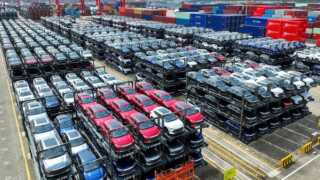Share via: Germany and Spain were the bright spots, each posting gains above 5 per cent. Yet the enthusiasm was not universal, Italy and the UK saw sales soften, reflecting an uneven recovery across the continent. …Read More Germany and Spain were the bright spots, each posting gains above 5 per cent. Yet the enthusiasm was not universal, Italy and the UK saw sales soften, reflecting an uneven recovery across the continent. (AFP) View Personalised Offers on Check Offers The European car market is beginning to stir back to life. August numbers brought some cheer as new-car registrations rose 4.7 per cent year-on-year to touch 791,349 units, according to the European Automobile Manufacturers’ Association. On the ground, this is a story of buyers slowly tilting toward electric and hybrid cars, while Europe’s carmakers are caught between ambition, costs, and a fierce Chinese challenge. Germany and Spain were the bright spots, each posting gains above 5 per cent. Yet the enthusiasm was not universal, Italy and the UK saw sales soften, reflecting an uneven recovery across the continent. What unites the region, however, is the growing curiosity about cars with a plug, even as pure EV adoption lags behind earlier forecasts. Also Read : European carmakers Renault, Volkswagen and Skoda fail to rev up sales in India A patchy road for EV ambitionsVolume carmakers are finding traction by nudging prices lower and making EVs more approachable. Luxury brands, though, are feeling the weight of high costs and fragile demand. Porsche, for example, quietly pressed pause on its plans for a battery-powered luxury SUV, deciding instead to lean on hybrids and even combustion engines to keep customers interested. Its parent Volkswagen, already wrestling with software headaches, has delayed the next electric Golf. Stellantis, too, had to drop its ambition for an all-electric Maserati sports car. Where demand is unmistakable is in plug-in hybrids. Registrations surged 56 per cent in August, a clear sign that many European buyers still prefer a halfway house between the old world and the new. Fully electric cars did grow too, up 27 per cent, but hybrids were the real crowd-puller. Also Read : Xiaomi plans to take on Tesla and BYD, targets European markets Markets cheer, despite industry strainsThe uptick was enough to move markets. Shares of Volkswagen, Stellantis, and Renault rose between 2–2.6 per cent on Thursday, adding to gains sparked by Washington’s decision to ease auto tariffs on the EU. Yet, this optimism comes amid a tough backdrop, Jaguar Land Rover continues to wrestle with supply chaos following a cyberattack, and Chinese makers like BYD are pressing hard with affordable models. The Munich Show of strengthAt the Munich car show earlier this month, German manufacturers staged a counter-offensive. BMW rolled out its €68,900 iX3 SUV, while Volkswagen unveiled the ID.Polo, a compact EV aimed at mainstream wallets and expected to be priced below Euro 25,000 next year. Winners, losers, and the BYD surpriseTesla’s struggles in Europe deepened, with sales dropping 22 per cent in August, reducing its market share to just 1.9 per cent. In contrast, Volkswagen, BMW, and Mercedes-Benz all gained ground. But the biggest surprise came from China’s BYD, which tripled deliveries in Europe, proving once again that the battle for the future of mobility is as much about affordability as it is about technology. Get insights into Upcoming Cars In India, Electric Vehicles, Upcoming Bikes in India and cutting-edge technology transforming the automotive landscape. First Published Date: 26 Sept 2025, 08:44 am IST
Source: hindustantimes.com






